| Example: Building Blocks Example | |
|
|
| Related Elements |
|---|
| Main Description | IntroductionThis section provides a detailed worked example showing how building block context is captured, how building blocks are identified, and how building blocks are defined when executing the major steps of the ADM. StructureThe levels of modeling within the ADM are explained in Building Blocks and the ADM , and the example follows the structure of modeling explained there:
Background to the ExampleIn this example, a fictional company called XYZ Manufacturing has decided to improve the efficiency of its mobile sales force by replacing paper-based configuration and ordering systems with an IT solution. The XYZ team have already done the preliminary stages of describing their existing system and reviewing it from a number of different viewpoints, and as a result have established a number of goals and objectives for the new system. The principal goal is to give the sales force in the field direct access to the sales process back at base. This will allow sales staff to create and verify the product configuration, to check the price and availability of the goods, and to place the order while actually with the customer. Other stages of the sales process - such as initiating the sale and determining the customer requirements - are considered to be outside the scope of this example. Identifying Building Block ScopeAs a preliminary to Phase B (Business Architecture), it is necessary to define the scope of activity, including what is in scope, what is out of scope, what the limits are, and what the financial envelope is. Within this step fall defining the business process, recording the assumptions made, and developing any new requirements. The information collected is used to gauge the baseline system and to determine the return on investment of potential changes. Use-cases are a useful tool in this step to describe the business processes and they can be used to do a sanity check against the resulting architecture. In the example in this section, the business goals driving improvements in the sales process were:
In this example, financial and time constraints and business return have not been dealt with in detail, but normally these constraints would be used to guide the process along the entire way to avoid over-engineering or "creeping elegance". The architect should especially look at these constraints whenever iterating between steps. Also not shown in this example are the use-case scenarios. However, the process described below does include participants, or actors, of the use-case with brief descriptions of their roles in Use-Case Table of Sales Process. For the sake of brevity in this example, it is assumed that the scope of the architectural work would not extend beyond the sales arena, and that the proposed solutions fit within the financial and time constraints imposed by XYZ. The assumptions made by the XYZ architect during Phase B are:
The relevant business process in scope of this example in the XYZ company is the customer-facing portion of the sales process and the supporting systems. This sales process consists of the following steps:
The following use-case table represents participants (sometimes referred to as "actors" in use-cases) in the rows, steps of the business process in the columns, and roles in the cells. Note that this is an example, and it is not intended to be accurate, but rather demonstrative. Constructing a use-case table is a comparatively small effort that will ultimately enhance the speed and quality of the resulting architecture. The meanings of the various acronyms used in the table, and in subsequent figures, are listed below:
Steps 1, 2, 6, and 8 are not within scope of the architecture work since the only participants involved are humans. The other steps are considered within scope since there are computing components involved in supporting the sales process. Note the computing participants are the first set of identified candidate building blocks - Business Process-Driven List. During Phase A, the business goals were developed into more detailed business requirements, and these were:
A very simplified view of the candidate building blocks required to support the business process with an idea of location is provided below. This model was built from elements of the above table. 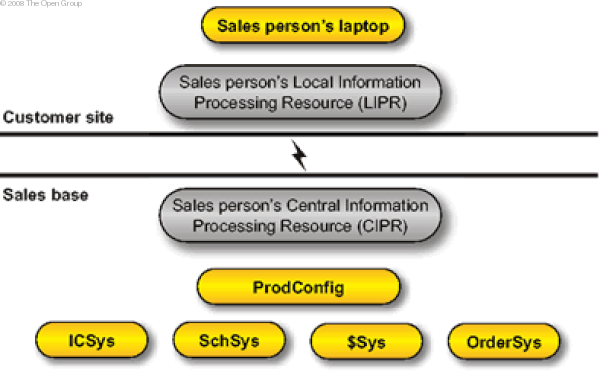
Identifying Building Block Requirements and ConstraintsThe objective of the first step in Phases B, C, and D of the ADM is to build a high-level description of the characteristics of the current system, re-usable building blocks from the current system, the technical functionality needed to address the business problem, and to identify additional constraints. This is necessary as the description documents the starting point for architectural development and lists the interoperability issues that the final architecture will have to take into account. Potential re-usable building blocks may be contained in the existing environment. They are identified in this step. The best approach is to describe the system in terms already used within the organization. A reliable picture can be built up of the business functions served and the platforms which support those functions. Gather and analyze only that information that allows informed decisions to be made regarding the Target Architecture. The inputs to this step are:
The essential outputs from this activity are:
The key input to this step is the Baseline Architecture. In this example, a depiction of a Baseline Architecture is shown in XYZ Baseline Architecture . Additionally depicted in this architecture model are pointers to existing problems with the Baseline Architecture. These pointers are used by the architect to determine where existing components are failing, and where existing systems can be re-used. 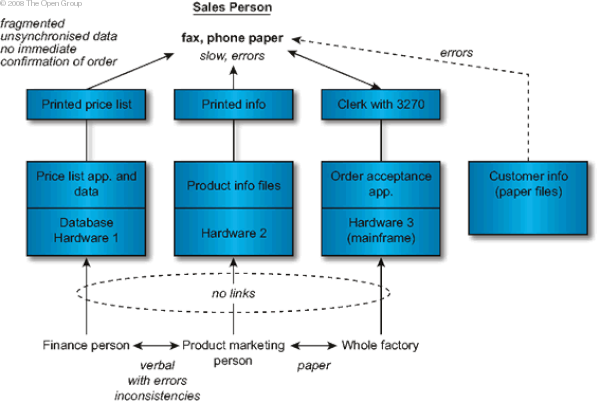
It is necessary to record strategic decisions about the existing architectural and technological issues such as:
The next step consists of restating the business process, considering what functionality will be required, and deciding what constraints apply. Decisions at this stage are not definitive, but act as input for the following steps and iterations. The architects of XYZ identified the following pieces of technical functionality as necessary to support the business processes. This list was produced using standard brainstorming techniques. Assumptions of Required Technical Functionality
Also in the brainstorming session, some assumptions were made and therefore must be documented as they should be used throughout the process:
One constraint was put on the development because XYZ already had systems in place to support the sales process:
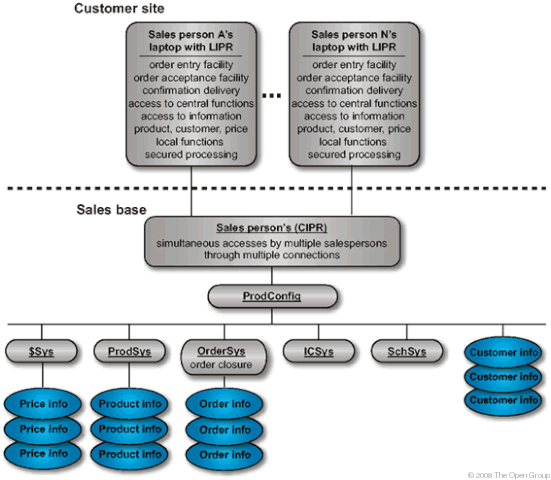
The above model is scrutinized and questions are asked about the functionality that could be provided by the existing system. Candidate Building Blocks from the Baseline-Driven List depicts the set of candidate building blocks from the existing system, resulting from this question. 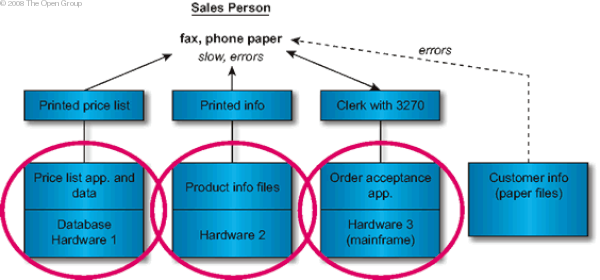
Architecture ModelingIn Phases B, C, and D a number of different architecture views are considered and used to build up a model of the new architecture. At XYZ, the architectural model level was developed in the following steps:
In executing Step 1, the Baseline Architecture was assessed:
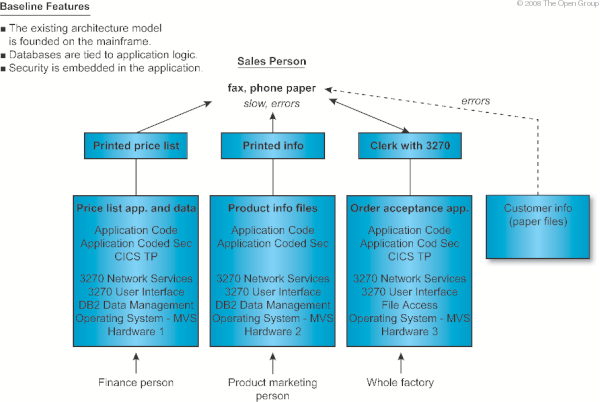 Notice how in Baseline Architecture in TOGAF Terms and Target Architecture of Functions the legacy systems supporting the price list, product information, and order acceptance applications are easy to handle as monolithic building blocks. Augmented Target Architecture of Functions , Representation of XYZ SalesApp System , and Services Map show they can be connected to new building blocks using adapters. In Step 2, the function view was examined based upon what the system was intended to do, and how it should behave. The function view is depicted in Target Architecture of Functions . Note that the inventory control and scheduling system are not covered. 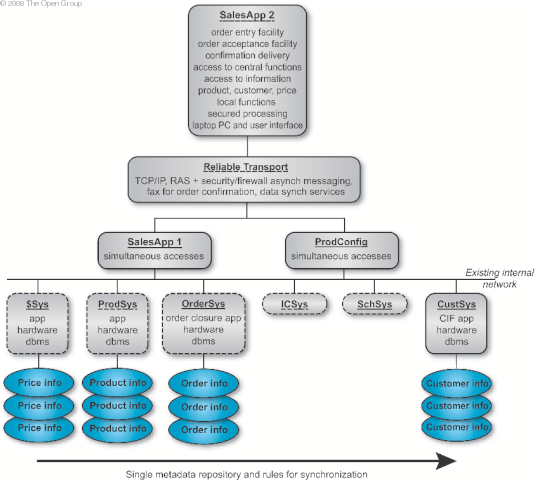
In executing Step 2, a view of the Target Architecture was created by processing the technical functionality that must be provided by:
 Augmented Target Architecture of Functions shows how the constraints identified in the earlier technical functionality and constraints work have been incorporated. It was necessary to retain the existing systems for order handling and product information. The initial constraint list also included retaining the existing system for customer information, but this was overridden by the need to improve the quality of the sales process and a new system is proposed to deal with this. Return on investment is the driving force behind the decision to retain the existing system for price data. Quality problems with the price system highlighted in XYZ Baseline Architecture will be resolved through a single metadata definition and rules for synchronization as shown in Target Architecture of Functions . These legacy systems are integrated into the new SalesApp (Sales Order Application) by developing adapter software. The following describes the SalesApp application.
To ensure that building blocks are as re-usable as possible, detailed information is needed about the building block. For this reason it is helpful to take views of individual building blocks and not just of the complete system. For the maximum benefit, it may be necessary to take views of both ABBs and SBBs. It is the responsibility of the architect to foresee the integration of any application with the rest of the enterprise regardless of the isolated position of the application today. This future integration is facilitated by complete definition of building blocks. It is the responsibility of the business unit to implement in accordance with the rules of the architecture. Step 3 consists of creating an architecture model of building blocks. Augmented Target Architecture of Functions depicts a Target Architecture model of functions, but does not express the relationships and interfaces between the elements in the architecture model. As the architectural development process continues, it becomes important to define a manageable granularity for building blocks and to fully define their linkages. Without this work there is no guarantee of interoperability between the various building blocks chosen. We have identified two lists of candidate building blocks in the above steps. Prior to building a model of building blocks, these lists are processed and some candidates become recommended building blocks.
The process of identifying building blocks includes looking for collections of functions which require integration to draw them together or make them different. First, it is recommended that the candidate building blocks from list B be selected as building blocks because they are re-usable legacy items. With these, a building block containing all the adapters is identified given the affinity of similar logic; e.g., providing the network adapter functionality on behalf of all the legacy applications. Next a network building block appears to be required as it is a new network that must be built or purchased and is independent of the applications implemented. It itself can be a re-usable building block for other applications. The laptop with the SalesApp2 application is identified as a building block because it is a modular pack of functionality specially built with applications and data tightly integrated for the mobile sales force. However, a RAS-capable firewall was also identified as a separable building block. The new customer information system is also identified as a re-usable building block given its applicability across applications past, new, and future. The SalesApp1 and configuration systems were identified as two additional building blocks. We depict the ABBs at a high level in Representation of XYZ SalesApp System . 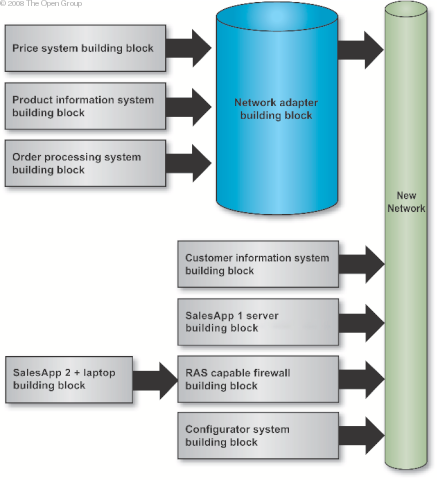 Representation of XYZ SalesApp System presents a relationship view of the system. Compare this with Augmented Target Architecture of Functions , a functional view, to see how different diagrammatic views of the same system can be used to show different things. In executing Step 3, the Target Architecture was created by processing the technical functionality that must be provided and:
Step 4 is to select the services portfolio required per building block. Services Map depicts the services mapped to components in the architecture model. 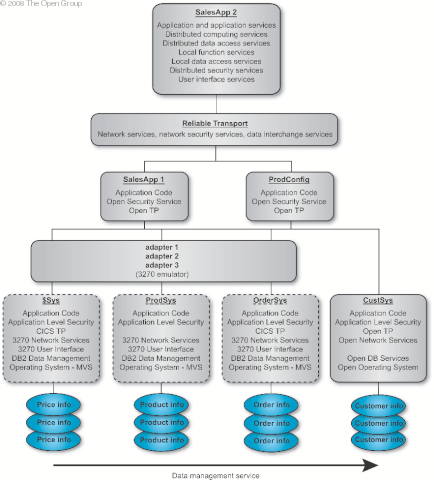
Step 5 in the process is to confirm that the architecture supports the business goals and objectives. This is a relatively subjective task of answering the questions developed in Step 1. In this example, we did not establish a set of questions that would be used to test the architecture, but such questions (and how to pose them in light of the architecture) could easily be envisioned. For example, one question could be: "Does the architecture prohibit the immediate processing of an order by a customer?" which would be answered "no" in our case above. The use-cases developed earlier are a handy tool to test the completeness and applicability of the architecture and its building blocks. Building block specifications should be recorded in detail. An example of a building block specification document is given in Customer Information System Building Block Specification. Where an enterprise architecture exists or is being developed, it may be valuable at this point to review the new set of building blocks. Anything of benefit to the wider enterprise should be abstracted back to an architectural level and then fed back into the enterprise architecture development process. Step 8 is to conduct a gap analysis, and is not covered in this example. Customer Information System Building Block SpecificationDescriptionThis system is put in place of the existing paper-based customer information system to support the goal of improving the speed and quality of order closure. It shields the database from the complexity of the many applications looking at it, but it contains an architectural break-point which could be used later on to make the database itself accessible to other applications.
The interfaces selected must go through an internal approval process modeled on the interface adoption criteria of The
Open Group. This means that all specifications must be or become part of the corporate Standards Information Base
(SIB).
Mandated Building Blocks
|
|---|
|
Building |
|
Required |
Named Used |
|---|---|---|---|
|
Block Name |
Owner |
Functionality |
Interfaces |
|
Enterprise Management System |
Corporate IT |
Service-level data handling |
|
|
|
|
Integration - TBD |
|
|
Enterprise Network |
Corporate IT |
|
|
|
CIF System |
Marketing |
|
|
Map to Business Organization Entities and Policies
|
Policy |
Entity |
Comments |
|---|---|---|
|
Security |
Corporate admin |
|
|
Audit |
Corporate admin |
|
|
Development and deployment |
Corporate IT |
|
|
Metadata definition |
Corporate IT |
|
|
Data quality |
Corporate IT |
|
|
IT architecture |
Corporate IT |
|
|
Corporate SIB |
Corporate IT |
This is linked to The Open Group SIB. |
Opportunity Identification
This is the step where projects are identified, ranked, and selected.
The steps illustrated above have laid the foundation for this analysis. Augmented Target Architecture of Functions , for instance, shows the SalesApp applications, the reliable transport, the adapters, and the new customer information system as potential projects.
Building Block Re-Use Level
In ADM Phases F to G, the choice of building blocks may be affected by outside events, such as a change in the availability of products. They can also affect and be affected by issues such as the cost of retraining users during migration from one product to another. Perhaps the most important impact though is the effect that building block choice can have on other work in progress within an organization. This section shows how a diagrammatic representation of the building blocks in a system can be used to identify or prioritize future projects.
An important benefit of defining the building blocks and their linkages is that it becomes possible to pick out re-usable components in the architecture. The best way to do this is to draw up a matrix of the building blocks used in an architecture and the applications that use them. Such a matrix for a simple subset of the XYZ case is shown in Simple Component/Application Matrix .
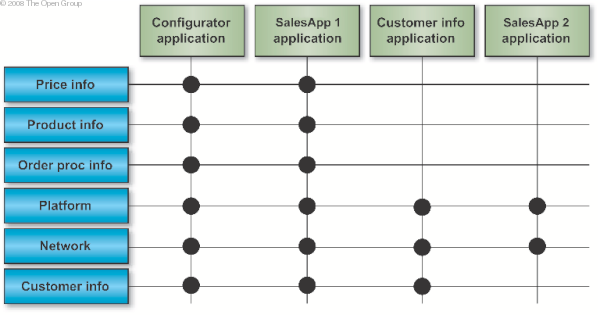
Careful ordering of the building blocks in the left-hand column allows the architect to identify subsets of functionality common to a number of applications. Identifying Common Functionality shows such a subset. In this case, the subset of platform, network, and customer information database gives a strong indication that the configurator, SalesApp1, and customer information applications should be hosted on the same platform.
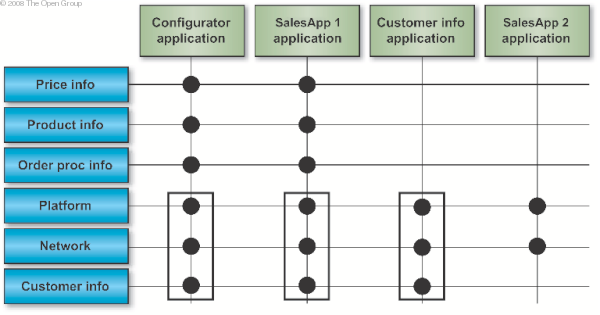
Such identifiable subsets of building blocks also serve another purpose, which is that they can draw attention to opportunities for component re-use. If, in the future, XYZ decides to implement a customer care system, adding that into the matrix reveals that there would be significant advantages to building the customer care system on the same building blocks used for the configurator, SalesApp1, and customer information applications.
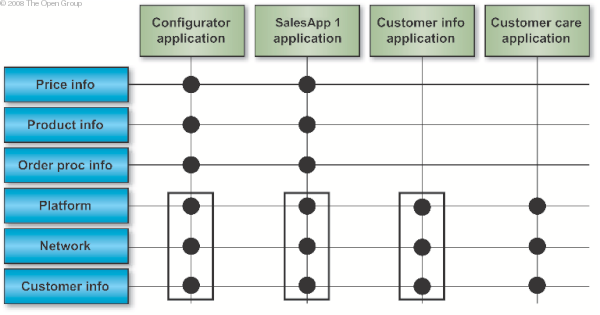
The key to success in working with building blocks is to establish a useful level of granularity. Too much detail in the chosen set of building blocks will make the architecture unworkable, while too coarse a level of detail will make the work valueless.
The Open Group gratefully acknowledge Capgemini for the creation of the Eclipse Process Framework Method Plugin for TOGAF9. Downloads of the TOGAF documentation, are available under license from the TOGAF information web site. The license is free to any organization wishing to use TOGAF entirely for internal purposes (for example, to develop an information system architecture for use within that organization). A book is also available (in hardcopy and pdf) from The Open Group Bookstore as document G091.
Copyright © 1999-2009 The Open Group, All Rights Reserved |